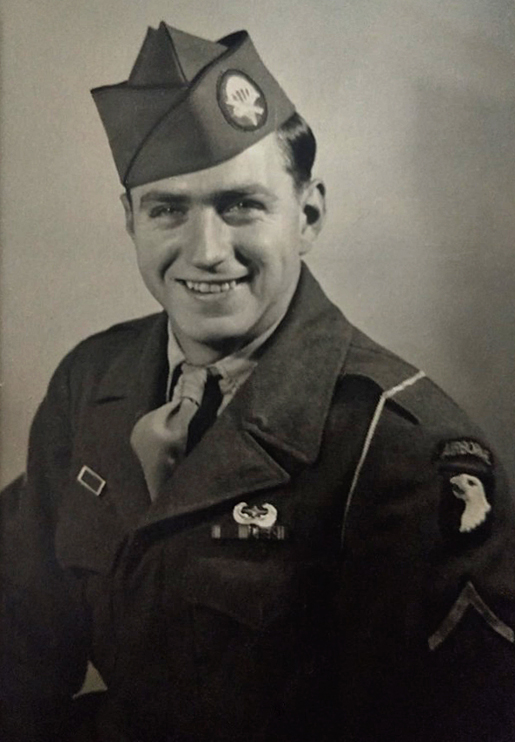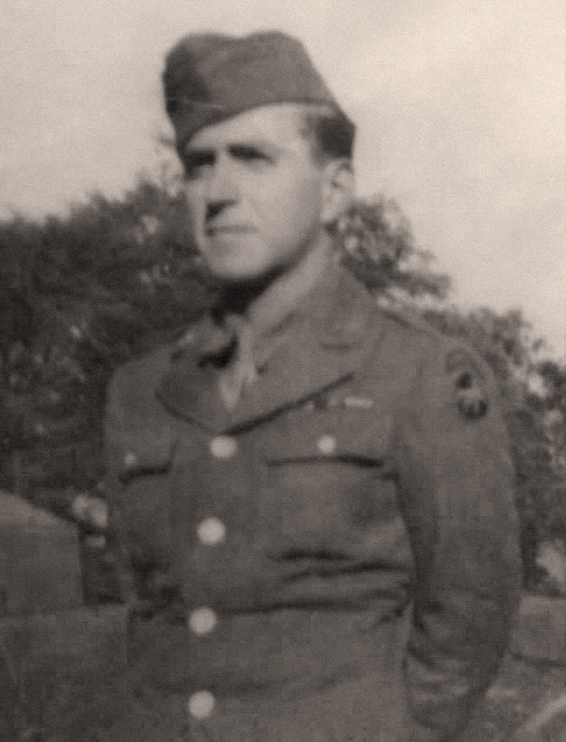Buffalo & Western New York Vets Who Served in the
United States Army
T5 Martin C. Bates
Lancaster, NY
Paratrooper
Headquarters & Service Battery
681st Glider Field Artillery Battalion
17th Airborne Division
Belgium, Germany
Martin Bates served as a Private with the HQ Battery of the 681st GFAB, which provided fire support
for the infantry units of the 17th Airborne Division. Unlike their infantry brethren, who parachuted into
battle, the 681st, with their mobile field guns, rode down into the fray inside of Waco CG-4 gliders.
The 17th's combat debut came during the German Ardennes Offensive in December of 1944 and January
of 1945, better known as 'The Battle of the Bulge'. However, despite being an airborne outfit, the 17th did
not jump into the Ardennes, unless you count the jump of a few feet off'a the back of a 2 1/2-ton truck!
(Paratroopers referred to this as a 'tailgate jump'.) The 17th was flown over to France from England and
trucked into the Ardennes area from Rheims. The division got its first taste of combat west of Bastogne
on January 4th, 1945. It was a rough introduction, with heavy losses suffered, but the 17th fought
through to the end of the battle on January 25th, learning some difficult lessons along the way.
After more than a month of rest, on March 24th, 1945 the 17th took part in its only airborne operation
of the war, dropping into Germany under parachutes and inside Waco CG-4 gliders near the towns of Wesel
and Hamminkeln during Operation Varsity, the airborne phase of Operation Plunder, the Allied crossing
of the Rhine River into Northern Germany. It was the largest one-day airborne operation in history and was
successful in facilitating a quick breakout from the Rhine by the other allied forces which had bridged
the river. Roughly a month and a half later, on May 7th, 1945, Germany surrendered.
A few months after the end of the war in Europe the 17th Airborne Division was deactivated and its personnel
were reassigned to other divisions; Martin Bates transferred to the 101st Airborne Division and was promoted
to the rank of Corporal, Technician 5th Grade. He was discharged from the US Army on January 6th, 1946.
His medals include the American Service Medal, Good Conduct Medal, EAME Service Medal with Bronze
Arrowhead (the arrrowhead signifies his glider landing during Operation Varsity) and the WWII Victory Medal.
This photo provided by Martin's daughter, Annette, was taken after he had
transferred to the 101st Airborne and before his promotion to Corporal/T5.

Courtesy of Annette Kerce
And here's Martin while he was with the 17th Airborne.

Courtesy of Annette Kerce
A Waco CG-4 Hadrian... the type of glider used by the 681st GFAB as well
as other glider-borne units within the 17th Airborne and other airborne outfits.

National Museum of the United States Air Force
'Twas pretty close quarters inside a 'Flying Coffin', as the gliders were referred to.

US Army Signal Corps photo
These two photos show the 105mm Howitzer M3, the same type of gun used by the 681st
GFAB. The M3 was a smaller, lighter, more mobile version of the 105mm Howitzer M2,
and was designed specifically for airborne use, though other army outfits also used it.

Rayford Edwin Alexander collection - The National WWII Museum

Rayford Edwin Alexander collection - The National WWII Museum
These next couple'a photos show troopers from the 82nd Airborne loading an M3 105mm
Howitzer into a CG-4 in North Africa prior to Operation Husky, the invasion of Sicily.
The 681st GFAB's preparations for Operation Varsity would have included many
similar scenes, though I'd wager with much less sand and more greenery!

National Archives and Records Administration via Fold3

National Archives and Records Administration via Fold3
The airborne even brought their own wheels along...

National Archives and Records Administration via Fold3
These next two photos are said to have been taken from inside CG-4s on the day of
Operation Varsity, with the first shot showing the tow line running from the glider to its
tug, a C-47 Skytrain. The wire wrapped around the tow rope is a communication line.

National WWII Glider Pilots Association

National WWII Glider Pilots Association
This photo, taken on the day of Varsity, shows members of the 194th Glider Infantry
Regiment shortly after emerging from their CG-4 Hadrians near Wesel, Germany.

National Archives and Records Administration
Nothing in war ever goes 100% to plan. The British and Canadians also took part in Operation
Varsity and were assigned their own landing zones and objectives. Some of the American pilots
flying the glider tugs were disoriented by morning fog that had not yet burned off when they
arrived over Germany, and towed their gliders to the wrong landing zones. This photo shows the
result; a mixed bag of American CG-4s and British Horsa gliders in the same landing zone.
Despite the 'oopsie', those of the 17th Airborne who were affected by the mixup were still able
to achieve their objectives while helping the Brits out with their objectives at the same time.
Of the three gliders closest to the camera, note that the one on the right is completely burned
out. As the operation took place during daylight, not only were many aircraft shot down by anti-
aircraft fire, but the gliders also took heavy fire from enemy ground forces as they were landing,
and many paratroops undoubtedly never made it out of their aptly-named 'flying coffins'.
'Tis just one grim example of the risks involved in military glider operations.

National Archives and Records Administration via Fold3
Again, things didn't always go so smoothly...

National Archives and Records Administration via Fold3
Gliders... gliders... and more gliders... as far as the eye can see.
This reconaissance photo was taken the day after Varsity and shows at least 80 of the
roughly 1,300 gliders that were used for the operation. Not only was it the largest one-day
airborne operation in history, it was to be the last airborne operation of the Second World War.

From:
Portrait of War
Back to 'WNY Vets - US Army'










